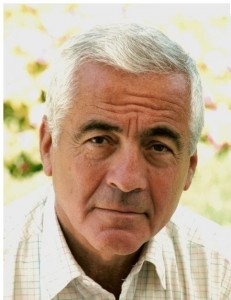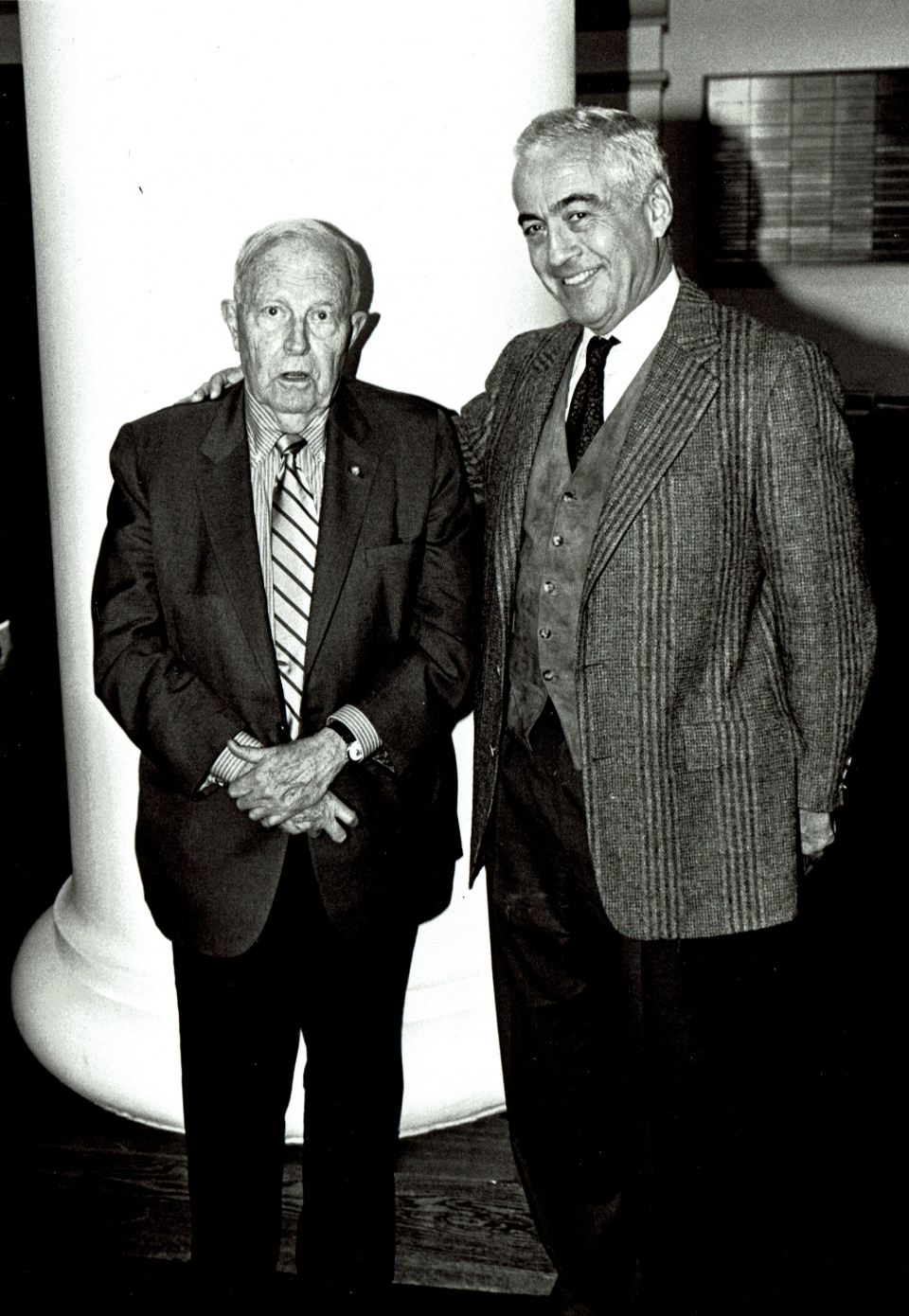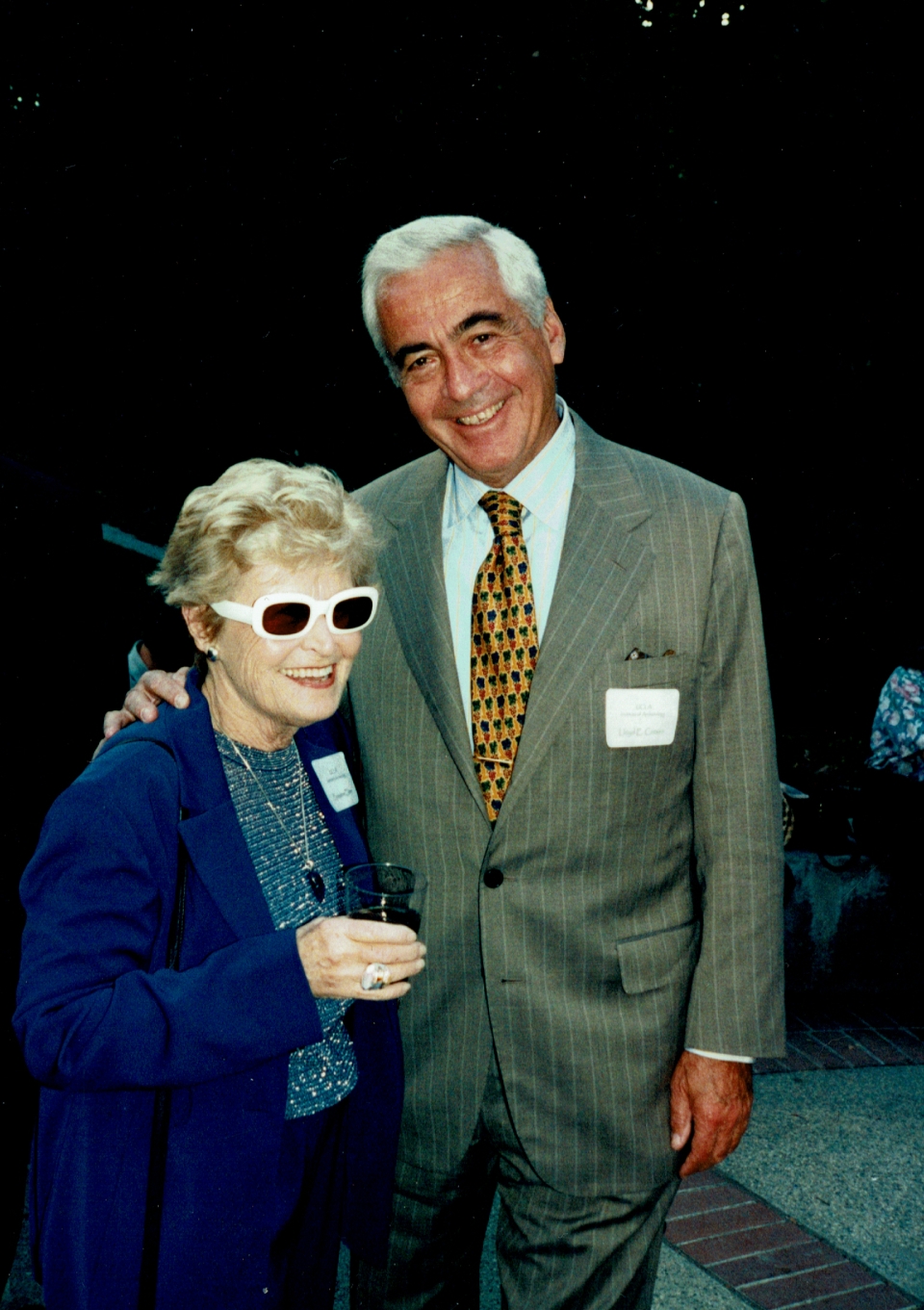A Tribute to Lloyd E. Cotsen
It is with great sadness that we have learned that Lloyd E. Cotsen has passed away on May 8th, 2017. The Institute of Archaeology proudly carries his name and we often refer to ourselves as “the Cotsen family”, a closely knit community of archaeological faculty, staff and students. We owe so much to his personal involvement and his generosity, which includes his financial largesse, but most of all his love for archaeology and his critical support of the Institute. The students who have never had a chance to meet him should know that this was a man who paired business acumen with wisdom and a great sense of humor.
In 1997 Ernestine Elster wrote an archaeological biography, honoring Lloyd Cotsen, and she expresses his love for archaeology better than we ever could. She has allowed us to reproduce the text here.
Lloyd Cotsen, a Brief Archaeological Biography
Ernestine S. Elster
University of California, Los Angeles
Hanging on the wall of the small museum at the prehistoric site of Lerna in the Peloponnesel are a series of drawings of architectural features from the site signed by the architectural draftsman, Lloyd E. Cotsen and dated beginning in 1954. Examining these professional renderings on a visit to Lerna back in 1965, my husband, Sandy, and I had the first inkling of the depth of Lloyd Cotsen’s involvement in archaeology. He and his wife JoAnne (now deceased) were friends of long standing but we weren’t close then. We took for granted that he was an important part of the Neutrogena Corporation with an interest in archaeology. Our understanding was only half correct; he was integral to Neutrogena and ultimately responsible for the enormous marketing success of its products. But concomitantly, since the date of the drawings, he had been in the archaeological trenches every summer alongside his academic colleagues. And it was only when the digging concluded at one of his favorite sites in Greece, that he cut back on this annual active involvement. It wasn’t simply an interest in archaeology, but a passionate participation.
Lerna was an eye-opener in more ways than one. First of all, the site was the stuff of which legends are made: a prehistoric site, one of a handful on the Greek mainland when it was first excavated, with remarkably preserved architecture and material remains representing a long sequence from Neolithic through Bronze Age. Further, this excavation was under the direction of a highly respected archaeologist, Jack Caskey of Cincinnati, who himself had worked with the legendary C.W. Blegen. If Lloyd’s work for Jack was hung on the walls, he was judged a professional by his peers!
But this brief archaeological biography will reach back even further than the beginning of our friendship, to the midpoint of this century, when Lloyd graduated from Princeton in 1950. He then served as a Naval Officer in the Pacific during the Korean War, and in 1953 after his discharge, he and JoAnne Stolaroff of Los Angeles were married. By 1954 he entered Princeton’s Graduate School of Architecture, and that summer he and JoAnne traveled to Greece. His title was Field Architect at Lerna. And thus began summer after summer of dirty hands, sweaty bodies, and a lifelong passion for and with archaeology.
Jack Caskey couldn’t have imagined much about the graduate student from the School of Architecture (the second choice, Lloyd insists), who accepted the summer job as field architect. But, as Jack would learn, this handsome, disarming, charming, and energetic young fellow developed into a lifelong archaeologist whose connection to the discipline grew deeper year by year. Along the way, Lloyd became a father, (1) a captain of industry and a philanthropist of enormous vision and creativity. (2)
But, not quite so fast, because during the 1954 field season, Caskey obviously realized Lloyd’s potential as an archaeologist. He offered Lloyd the opportunity of graduate study as a Fellow of the American School of Classical Studies in Athens. In the space of the next few years, Lloyd and JoAnne lived and breathed archaeology in Athens and business and marketing in Cambridge at Harvard’s Graduate School of Business Administration. But I think the ASCS and the summers in the field were a transformative experience for Lloyd. They provided him with an understanding of how archaeology worked, in the field, lab, and classroom, and in a foreign land. He developed a network of friends and colleagues and an ongoing link with the ASCS and archaeologists in Greece which is undiminished through time.
Lloyd graduated from Harvard in 1957 and at that juncture his father-in-law invited him to join his company (the forerunner of Neutrogena), with time out every summer for excavation in Greece. Lloyd was the head of a young and growing family; he accepted. As for Neutrogena, we will leave that for another biography.
While a fellow of the American School and during the many field seasons in Greece, he mastered quite a bit of Greek. As the story goes, Lloyd would arrive on site, size up the situation, and immediately set about pouring oil on any troubled waters, relying on his own inimitable brand of enthusiasm and excitement. He was in the field, his architect’s tools unpacked, his beard growing by the day, his body sunburned, and his soul transformed from merchandising genius to working scholar. He has applied his skill, creativity, and vision to many archaeological worlds, in addition to field work at Lerna, Kea, and Pylos. Mozan and Urkesh received working visits from Lloyd as did Marija Gimbutas’ site in Italy at Scaloria Cave. And in 1991 Lloyd and I planned, with Giorgio and Marilyn’s collaboration, a joint excavation of a hgan with Dr. Alexander Djavakishvili and the Archaeological Museum in Tbilisi, Georgia. By spring of 1992 I learned that our funding from the National Research Center was approved in Washington, D.C., but in the end, it was not to be; Georgia was wracked with political unrest and we did not accept the grant.
Observing from within the strengths and pitfalls of archaeological projects, he developed a keen awareness for that characteristic problem of field archaeology-the publication of excavation reports. And he set out to provide means to solve the problem. We at the Institute of Archaeology at UCLA have benefited from this interest in publications, special annual lectures, student support, and excavations. The JoAnne Stolaroff Cotsen Prize Imprint, named in honor of his late wife, is awarded to an outstanding Institute of Archaeology publication. The award provides support for printing, an honorarium to the author who is invited to UCLA to present a public lecture, and a seminar. The Marija Gimbutas Memorial Lecture provides funding and an honorarium to a special guest archaeologist for a lecture on Indo-European and/or Bronze Age archaeology; the Cotsen Family Foundation has provided grants for manuscript preparation of excavation reports. Lloyd has served on the Advisory Board of the Institute of Archaeology since the inception of this Board, and contributed generously to the first and most recent Capital Campaign. In recognition of his generosity, vision, and participation, the Institute honored him with its “Silver Trowel Award,” its highest honor.
The American Institute of Archaeology, for which he has been active over the years as Trustee and former President of the Southern California Society, also honored him a few years back. He has served as Chairman of the American School of Classical Studies in Athens since 1993, but his actual work for the School has gone on for years and can be characterized as thorough and fair-minded. He has offered rare diplomacy in sorting out the vexatious problems of aging excavation reports and provided financial support for a number of scholars at various institutions, thus helping to bring these languishing works to scholarly hands. He has provided scholarships, usually without fanfare, for talented students here and abroad. As a member of the Ahmanson Board of Trustees (an important philanthropic agency in Los Angeles), he has encouraged applications of an archaeological nature while at the same time challenging unrealistic goals.
As I reach the end of this biographical sketch, it becomes clear how much Lloyd Cotsen has avoided honor and outward recognition, concentrating instead on continuous substantive involvement. Thus it is that his “works” honor him as the man and the archaeologist; his friends and colleagues know of his dirty hands and sweaty brow, and you and I, as working scholars, honor him with pride, for work rendered.

Robert H. Ahmanson, Lloyd E. Cotsen, Ernestine Elster, and Richard Leventhal
(1) Proud father of Corinna, Tobey, Eric and Noah (now deceased), and grandfather.
(2) An abbreviated list of achievements runs something like this: two honorary Ph.D. awards (Cincinnati 1994 and Pepperdine 1993); noted collector of folk art for himself and Neutrogena and then donated to New Mexico Folk Art Museum in Santa Fe to be housed in a new wing of the Museum specifically built for this extraordinary collection; Chairman of the Los Angeles Music Center Managing Committee; Board of the Los Angeles Craft and Folk Art Museum, Skirball Museum; Charter Trustee of Princeton University; probably the nation’s leading collector of children’s books, housed in the Cotsen Children’s Library, a part of the Firestone Library at Princeton; provided support for and helped design a program of Story Telling for Children at rural libraries in a remote river valley in Colorado; commissioned a biography of Newberry, the publisher of children’s books, whose name graces the medal for outstanding children’s publications; commissioned a study of bamboo and its various uses including for the creation of basketry art, illustrated from his fine collection of Japanese baskets; etc.
To see the link to the Elster's article online, please click here.
To view a copy of Urkesh and the Hurrians Studies in Honor of Lloyd Cotsen, please click here.





